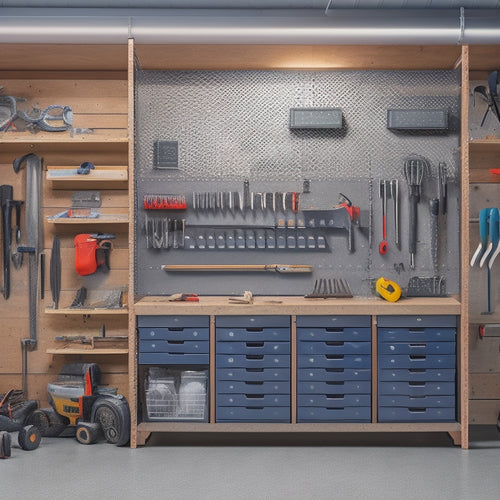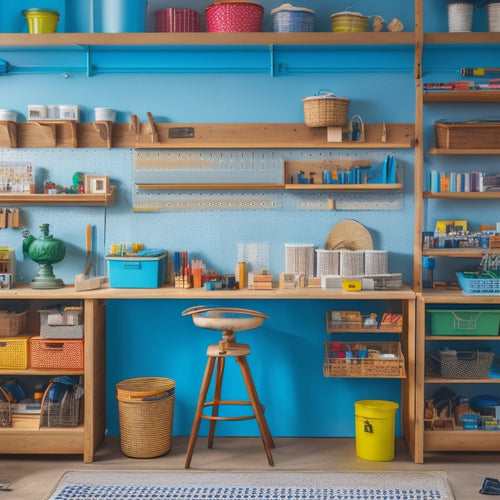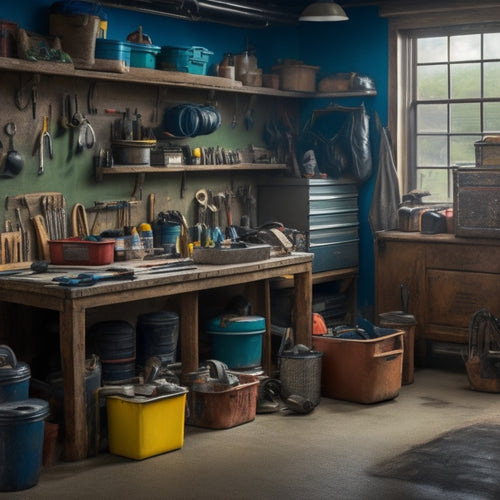
What's the Secret to Fitting More in Small Spaces?
Share
You're about to reveal the secret to transforming your small space into a functional and organized haven. Start by corralling tools into designated zones, assigning a home for each item, and implementing space-saving solutions like pegboards and hooks. Measure your toolbox precisely, considering obstructions, and look for space-saving solutions. Focus on multi-purpose tools, compact designs, and multi-tasking furniture pieces. Strategically stack and layer belongings, identify items that can be stacked, and create clever arrangements. Utilize vertical space effectively with floor-to-ceiling shelving and hanging storage options. Now, visualize your space as a three-dimensional puzzle, and get ready to discover even more clever solutions to maximize your small space.
Key Takeaways
• Assign a designated home for each item to reduce clutter and optimize space in small areas.
• Utilize vertical space by installing shelves, hooks, and baskets to maximize storage potential.
• Implement space-saving solutions like adjustable dividers, removable trays, and multi-purpose tools.
• Strategically stack and layer belongings to create a visual hierarchy for storage and maximize space.
• Declutter regularly using techniques like the One-Touch Rule, 80/20 Rule, and Joy Test to free up space and reduce clutter.
Tool Organization Strategies
To maximize your small space, start by corralling your tools into designated zones, assigning a home for each item to prevent clutter from creeping back in. This is the foundation of effective tool organization strategies.
By creating separate areas for specific tasks, you'll reduce the time spent searching for misplaced tools and increase productivity. Implement space-saving solutions like pegboards, hooks, and bins to keep frequently used items within easy reach.
Consider a modular tool arrangement, where you group similar tools together, making it easier to access what you need when you need it. This thoughtful approach will help you maximize efficiency and free up valuable space.
Visualize your ideal workspace and create an organization system that works for you. With a little creativity, you can turn even the smallest area into a well-oiled machine.
Measuring the Toolbox Space
When you're working with a small toolbox, every inch counts, so it's crucial to take precise measurements of the space.
You'll want to jot down the length, width, and height of the toolbox, as well as the dimensions of any shelves or compartments it may have.
Toolbox Dimensions Matter
Measure the length, width, and height of your toolbox space to determine the maximum dimensions of the toolbox you can fit in it. You'll want to take precise measurements to ensure a snug fit. Don't forget to take into account any obstructions, such as pipes or electrical outlets, that may impact your toolbox's placement. By doing so, you'll be able to find the perfect compact toolbox that maximizes storage without taking up too much space.
When selecting a toolbox, look for space-saving solutions that cater to your specific needs. Take into account a toolbox with adjustable dividers or removable trays to create an efficient layout that suits your tools and equipment. This will allow you to make the most of your toolbox's capacity, keeping your workspace organized and clutter-free.
Tool Space Utilization
Visualize your toolbox space as a three-dimensional puzzle, and you're about to solve it by plotting the exact dimensions of the area where your toolbox will reside. Take out your tape measure and record the length, width, and height of the space.
Don't forget to note any obstacles, such as pipes or electrical outlets, that might impact your toolbox's placement.
Now, think creatively about how to maximize this space. Consider space saving solutions like tiered storage or hanging tool organizers.
You can also optimize your toolbox's interior with clever organization systems, such as dividers or inserts, to make sure every tool has its own designated spot.
Selecting the Right Tools
As you prepare to stock your compact toolbox, you're faced with an important question: which tools will make the cut?
You'll want to focus on items that serve multiple purposes, have a compact design, and fit seamlessly into your measured space.
Measuring the Space
You'll need to gather a few essential tools to accurately capture the dimensions of your small space, ensuring a successful fit. A tape measure, pencil, and paper will become your best friends in this process.
Start by measuring the length, width, and height of each wall, as well as any obstructions like windows, doors, or pillars. Don't forget to note the location of electrical outlets and switches.
As you measure, think about space utilization and how you can maximize storage. Consider the height of your ceiling and how you can use vertical space to your advantage. Take note of any corners or nooks that can be optimized with clever storage solutions.
Make sure to record every measurement, no matter how small, as it will impact your overall design.
With your measurements in hand, you'll be able to create a detailed floor plan, ensuring that every piece of furniture fits snugly and efficiently. By taking the time to accurately measure your space, you'll be able to create a functional and stylish area that serves your needs.
Choosing Multi-Taskers
With your space's measurements in mind, select multi-tasking furniture pieces that can serve more than one purpose, like a storage ottoman that doubles as a coffee table. These versatile tools will help you maximize your space, allowing you to fit more in without sacrificing style or functionality.
Look for space-saving solutions that cater to your specific needs, such as a desk with built-in shelving or a Murphy bed with storage compartments.
When it comes to gadgets, opt for multifunctional ones that can perform multiple tasks, like a slow cooker that also serves as a rice cooker and yogurt maker. Consider compact design when choosing appliances, as they'll take up less room without sacrificing performance.
Compact Design Matters
Compact appliances and gadgets with sleek, space-conscious designs can be game-changers in small spaces, allowing you to fit more functionality into tight corners and narrow countertops. When selecting the right tools, look for space-saving solutions that won't compromise on performance.
For instance, a compact stand mixer can be a lifesaver in a tiny kitchen, freeing up counter space for other essentials.
Efficient storage is also key to maximizing capacity in small spaces. Consider investing in stackable containers, hanging organizers, or wall-mounted shelves to keep your belongings organized and out of the way.
Creative organization can make all the difference in a cramped space, allowing you to fit more in without feeling overwhelmed.
Stacking and Layering Options
By strategically stacking and layering your belongings, you can reveal hidden storage potential in even the smallest of spaces. This efficient organization technique allows you to make the most of your available space, creating a sense of calm and order in your home.
To maximize storage, start by identifying items that can be stacked, such as books, baskets, or containers. Then, consider clever arrangements that allow you to store items of varying sizes and shapes. For instance, you can place smaller items on top of larger ones, or use stackable shelves to create a vertical storage system.
When layering, think about creating a visual hierarchy, with the most frequently used items at the front and center, and less frequently used items towards the back or on higher shelves. By implementing these space-saving solutions, you'll be amazed at how much more you can fit in your small space, while still maintaining a sense of style and functionality.
Utilizing Vertical Space Effectively
You can access a wealth of storage opportunities in your small space by focusing on the often-overlooked area above your head, where walls, ceilings, and corners offer prime real estate for clever vertical installations. By maximizing height, you can create a sense of openness while keeping essential items within easy reach.
Consider installing shelving solutions that stretch from floor to ceiling, providing ample storage for books, decorative items, or kitchenware. Hanging storage options like baskets, hooks, or bins can also be used to store linens, accessories, or cleaning supplies, keeping them organized and out of the way.
To get the most out of your vertical space, think creatively about how you can use corners and alcoves. Install a pegboard or a set of hooks to hang frequently used items like bikes, tools, or bags. You can also use wall-mounted shelves or cabinets to store items that you don't need immediate access to, like seasonal decorations or out-of-season clothing.
Purging Unnecessary Items
In the pursuit of fitting more into your small space, it's essential that you first tackle the clutter that's holding you back, letting go of items that no longer serve a purpose or bring you joy. Embracing a minimalist lifestyle can be liberating, and it's the perfect opportunity to reassess what's truly important to you. Start by categorizing your belongings into three piles: keep, donate/sell, and discard. Be honest with yourself – when was the last time you used that item?
Here are some decluttering techniques to get you started:
| Decluttering Technique | Description |
|---|---|
| The One-Touch Rule | Handle each item only once to avoid unnecessary revisiting |
| The 80/20 Rule | 80% of the time, you likely only use 20% of your belongings |
| The Box Test | Place items in a box and set a deadline; if you haven't used it by then, let it go |
| The 6-Month Rule | If you haven't used an item in six months, it's probably safe to let it go |
| The Joy Test | If an item doesn't bring you joy or serve a purpose, consider letting it go |
Frequently Asked Questions
How Do I Handle Tools With Irregular Shapes or Sizes?
"When life gives you lemons, make lemonade" - and when you're dealing with irregularly shaped tools, create a custom foam insert or use adjustable shelves to snugly fit each unique piece, maximizing storage and minimizing hassle.
Can I Use Adhesive Magnets on Painted Metal Surfaces?
You can use adhesive magnets on painted metal surfaces, but make sure the paint is fully cured and the magnet is rated for the surface. This creative solution enables magnetic organization, perfect for maximizing storage in tight spaces.
Are Stackable Bins Compatible With All Toolbox Types?
As you visualize your dream toolbox, imagine stackable bins like building blocks, maximizing space. Yes, they're compatible with most toolbox types, offering a tailored space-saving solution for organized tool storage, freeing you to focus on serving others with efficiency.
What's the Best Way to Label Small or Hard-To-Reach Items?
You'll find labeling small or hard-to-reach items a breeze by using color coding and creative storage hacks. Try attaching labels to the top or side of bins, or use a label maker with removable tape for easy rearrangement.
Can I Use Toolbox Dividers to Separate Different Projects?
You can totally use toolbox dividers to separate different projects, keeping your project organization on track. This clever hack also helps with drawer management in small spaces, ensuring each item has its designated spot.
Related Posts
-

Building a Wall Tool Storage System
You're about to create a customized wall tool storage system that streamlines your workflow. Start by clearing your w...
-

Creative Workshop Storage Solutions and Ideas
You can revolutionize your workshop's storage by maximizing vertical space with wall-mounted racks, utilizing hidden ...
-

Best Cheap Tool Boxes for Budget-Conscious Buyers
You need a reliable tool box that gets the job done without breaking the bank. Look for durable materials, rust-resis...


